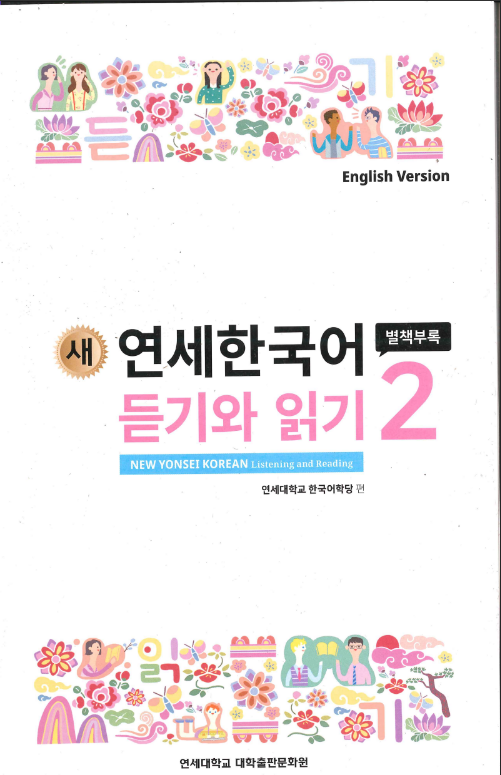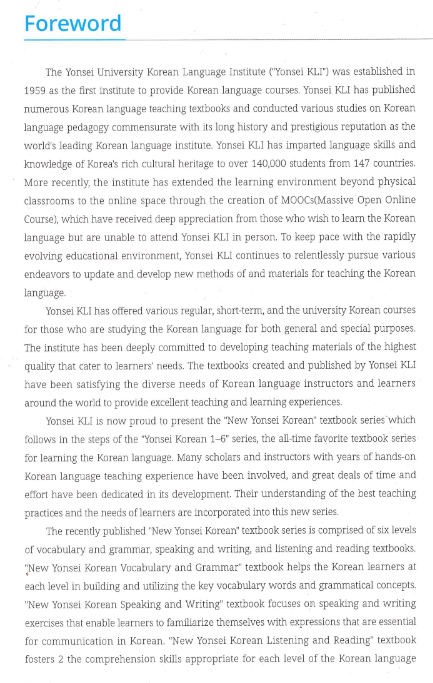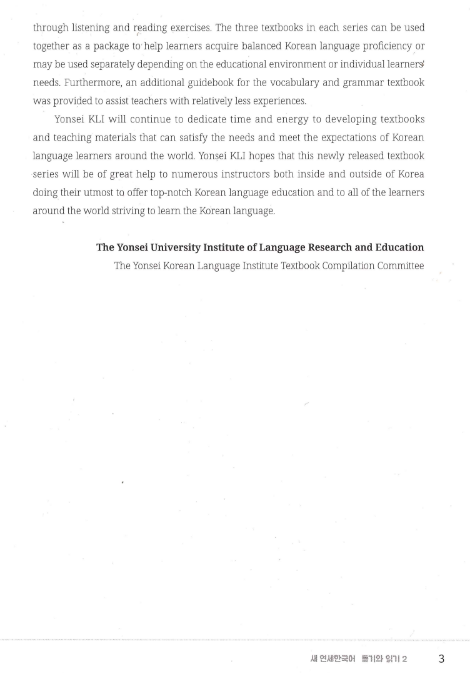Mục lục
Toggle


Foreword
The Yonsei University Korean Language Institute (“Yonsei KLI”) was established in 1959 as the first institute to provide Korean language courses. Yonsei KLI has published numerous Korean language teaching textbooks and conducted various studies on Korean language pedagogy commensurate with its long history and prestigious reputation as the world’s leading Korean language institute. Yonsei KLI has imparted language skills and knowledge of Korea’s rich cultural heritage to over 140,000 students from 147 countries. More recently, the institute has extended the learning environment beyond physical classrooms to the online space through the creation of MOOCs (Massive Open Online Course), which have received deep appreciation from those who wish to learn the Korean language but are unable to attend Yonsei KLI in person. To keep pace with the rapidly evolving educational environment, Yonsei KLI continues to relentlessly pursue various endeavors to update and develop new methods of and materials for teaching the Korean language.
Yonsei KLI has offered various regular, short-term, and the university Korean courses for those who are studying the Korean language for both general and special purposes. The institute has been deeply committed to developing teaching materials of the highest quality that cater to learners’ needs. The textbooks created and published by Yonsei KLI have been satisfying the diverse needs of Korean language instructors and learners around the world to provide excellent teaching and learning experiences.
Yonsei KLI is now proud to present the “New Yonsei Korean” textbook series which follows in the steps of the “Yonsei Korean 1-6” series, the all-time favorite textbook series for learning the Korean language. Many scholars and instructors with years of hands-on Korean language teaching experience have been involved, and great deals of time and effort have been dedicated in its development. Their understanding of the best teaching practices and the needs of learners are incorporated into this new series.
The recently published “New Yonsei Korean” textbook series is comprised of six levels of vocabulary and grammar, speaking and writing, and listening and reading textbooks. “New Yonsei Korean Vocabulary and Grammar” textbook helps the Korean learners at each level in building and utilizing the key vocabulary words and grammatical concepts. “New Yonsei Korean Speaking and Writing” textbook focuses on speaking and writing exercises that enable learners to familiarize themselves with expressions that are essential for communication in Korean. “New Yonsei Korean Listening and Reading” textbook fosters 2 the comprehension skills appropriate for each level of the Korean language through listening and reading exercises. The three textbooks in each series can be used together as a package to help learners acquire balanced Korean language proficiency or may be used separately depending on the educational environment or individual learners’ needs. Furthermore, an additional guidebook for the vocabulary and grammar textbook was provided to assist teachers with relatively less experiences.
Yonsei KLI will continue to dedicate time and energy to developing textbooks and teaching materials that can satisfy the needs and meet the expectations of Korean language learners around the world. Yonsei KLI hopes that this newly released textbook series will be of great help to numerous instructors both inside and outside of Korea doing their utmost to offer top-notch Korean language education and to all of the learners around the world striving to learn the Korean language.
The Yonsei University Institute of Language Research and Education
The Yonsei Korean Language Institute Textbook Compilation Committee
새 연세한국어 듣기와 읽기 2 3
Introduction
- This book, together with “New Yonsei Korean Language Vocabulary & Grammar 2” and “New Yonsei Korean Language Speaking & Writing 2” is for beginner-level Korean language learners.
- This book focuses on developing students’ comprehension so that beginner-level Korean language learners can understand what they have heard and read in Korean.
- This consists of 20 lessons and each lesson is made up of two sections, totaling 40 sections in all. For every two lessons, there is a separate review section, and there are a total of 10 review sections in the book. Each section consists of enough material for a 50-minute class, and the entire book contains 50 sections total. Every review section also contains a segment that introduces Korean culture.
- Each section of the book consists of a title, learning objectives, and a five-stage process, which includes a “Let’s Prepare” segment, “Let’s Listen” segment, “Let’s Read” segment, “Let’s Repeat” segment, and a “Let’s Organize” segment.
- Though the title of each lesson in this book is the same as the lesson titles of “New Yonsei Korean Language Vocabulary & Grammar 2,” the title of the section is a sentence from the contents of the section that best represent the lesson. In addition, a QR code is included next to each title so that learners can easily listen to the audio.
- The learning objectives are expressed in “can understand ~” and “can understand ~ -related materials” format to clearly state the comprehension function of the lesson.
- The “Let’s Prepare” segment is an introduction to the section and is a preparatory stage that helps learners understand the reading and listening contents of the unit. It consists of the study of necessary vocabulary related to the lesson content of the unit. However, it is not just a simple lesson on vocabulary; the vocabulary list consists of words that are actually used in the sentence or within the context of the dialogue so that learners can further their understanding of the words that are being used.
- “Let’s Listen” is formatted so that learners can improve their real-life communication skills by learning colloquial expressions. The listening passages begin with simple sentences, then conversations, and then formal discourse and ranges from short to long and easy to difficult passages.
- “Let’s Read” focuses on improving the communication skills of beginner-level Korean language learners in their usage of literary expressions in every-day situations. Students will read various forms of writings (memos, journals, emails, advertisements, invitations, blogs, internet forums, etc.) that they may come across in real-life situations and work on exercises to comprehend the contents of what they have read.
- “Let’s Repeat” seeks to help learners with their pronunciation. Vocabulary words from the listening or reading passages that include a phoneme change or have a high error rate have been selected per unit and are listed together with other words that follow the same pronunciation rules. The segment also includes sentences that include those specific vocabulary words.
- “Let’s Organize” is a segment that helps learners confirm and examine what they have learned and aims to strengthen students’ linguistic ability through an integrated learning method that incorporates other learning skills. This segment includes exercises where learners can integrate the contents of the listening and reading lessons with speaking and writing activities.
- “Review” is comprised of a reading and listening passage where learners can utilize the vocabulary, grammar, and contents of what they have learned in the preceding two lessons. Learners can focus on either listening or reading using what they have learned from each section and use an integrated learning method to connect the other remaining skill through these exercises.
- “Culture” is contained in the final portion of the Review Section as a cultural text and illustration. Cultural contents that are appropriate for comprehension purposes are selected and included to introduce contents about Korean culture.
- The Appendix includes an answer key and a list of vocabulary words and a separate booklet includes a translation of the reading passages, as well as listening passage transcripts and translations.
Contents Map
| Chapter | Title | Lesson objective | Expression | Culture (review unit) |
| Unit 1 Greetings and Introductions | <1> Greetings | to ask how a person is and understand the answer | -게¹<br>-어지다 | |
| <2> Introductions | to understand introductions about jobs and majors | -은 지<br>-으려고 | Titles | |
| Unit 2 Friends and Family | <1> My Friends | to understand descriptions and introductions about friends | -네요²<br>-겠다² | |
| <2> Meetings with Family and Relatives | to understand introductions of family and relatives and family gatherings | -을 때<br>-의 | ||
| Unit 3 Hometown | <1> The Hometown of my Friend | To understand the description of the location and environment of a hometown | -만에<br>-어 보다¹ | |
| <2> My Beautiful Hometown | To understand descriptions of the natural environment and the way of life of a hometown | -기 때문에<br>-는데² | The Houses of Koreans | |
| Unit 4 Houses | <1> House-Moving | To understand the content of preparing for a move and looking for a new house | -었으면 좋겠다<br>-어야겠다 | |
| <2> The House Where I Live in | To understand introductions of house chores and the house in which you live | -는 중이다<br>-나요? | ||
| Unit 5 Food | <1> Introducing Food | To understand introductions on how to eat food | -어 보다²<br>-는데³ | |
| <2> Food Ingredients and Cooking | To understand the explanation of ingredients for a meal and how to cook it | -은 적이 있다<br>-에다가 | Gwangjang Market | |
| Unit 6 Market | <1> Convenience Store | To understand the introduction to a shopping location | -을까요?²<br>-을 거예요² | |
| <2> Internet Shopping Mall | To understand the recommendations for places of shopping | -는데⁴<br>-어하다 | ||
| Unit 7 Shopping | <1> Things I Want to Buy | To understand the description of a situation where one is buying a product and what one wants to buy | -어도 되다<br>-으면 안 되다 | |
| <2> Introducing Products | To understand introductions of products you have purchased and descriptions of things you want to sell | -는<br>얼마나 -는지 모르다 | House-warming gifts | |
| Unit 8 Invitations | <1> Meeting Invitation | To understand the content of introductions and invitations to meetings | -어<br>-을까 하다 | |
| <2> House-warming Party Gift | To understand how to prepare a gift for and things related to a housewarming party | -어 가지고<br>-지 마 | ||
| Unit 9 Appointments | <1> Setting a Time and Place for an Appointment | To understand the content of an appointment made with friends for a meeting or gathering | -는다, -ㄴ다?<br>-을게요 | |
| <2> Changing an appointment | To understand the content of an appointment being changed or cancelled | -어라, -아라<br>-게 되다 | Popular Locations for Meeting Appointments | |
| Unit 10 Requests | <1> Asking a Favor to your Friend | To understand the content when asking and receiving a personal favor | -을래요?<br>-었다가¹ | |
| <2> Making a Request at the Office | To understand the content of a request made to strangers or at public institutions | -습니다만<br>-는지 알다 | ||
| Unit 11 Transportation | <1> Public Transportation | To understand the content of explanations of how to use public transportation | -다가<br>-으로³ | |
| <2> Directions | To understand the content of driving directions in a taxi or driving directions while driving | -으려면<br>-어서 해서 | Using the Library | |
| Unit 12 School Life | <1> Classes and Exams | To understand the content of explanations about classes and exams | -어야<br>-으면 되다 | |
| <2> School Programs | To understand the content of inquiries in the office about school life. | -는데요<br>-거나 |


